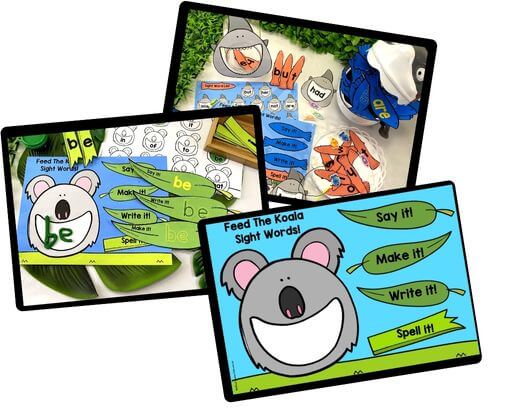Sight Words Teaching Resources
Reading Resources
Looking to develop pre-reading skills with your students? Our Sight Words Teaching Resources are the perfect solution! Packed with fun, hands-on, and engaging activities, worksheets, and sight word lists, they are designed to help young learners master sight words, also known as high-frequency words.
Sight words, often referred to as the first 100 most common words or “magic” 100 sight words, are the words that appear frequently in written text. They are crucial for building a strong foundation in reading and supporting the development of literacy skills.
These sight words include both regular and irregular words that are difficult to spell or sound out. Examples of these words are “who,” “the,” “he,” “were,” “does,” “their,” “me,” and “be.” By teaching and practising these high-frequency words, students become familiar with them and can recognize them instantly while reading.
First 100 Sight Words
The selection of the first 100 sight words is based on their frequency of occurrence in written texts. These words are chosen because they appear most frequently in the English language and are essential for early reading and writing development. The goal is to teach children to recognize these words instantly and effortlessly, as they encounter them repeatedly in various texts.
The first 100 sight words are often referred to as “high-frequency words” or the “Dolch sight words.” They include commonly used words such as articles (e.g., the, a), pronouns (e.g., I, you), prepositions (e.g., at, in), conjunctions (e.g., and, but), and other frequently appearing words (e.g., have, said). These words are typically irregular in terms of phonetic patterns and cannot be easily decoded using regular phonics rules.
By learning and memorizing these sight words, young readers can quickly recognize and comprehend them in the context of sentences, which helps to improve reading fluency and comprehension. Mastering these sight words is an important milestone in a child’s reading journey, as it allows them to focus on decoding and understanding more complex words and texts.
| the | of | and | a | to | in | is | you | that | it |
| he | was | for | on | are | as | with | his | they | I |
| at | be | this | have | from | or | one | had | by | word |
| but | not | what | all | were | we | when | your | can | said |
| there | use | an | each | which | she | do | how | their | if |
Why Teach Sight Words?
Mastering sight words is a critical part of the reading process. However, it’s important to note that sight words alone or in isolation will not help students become proficient readers. Sight word instruction should be integrated with other reading strategies and skills to ensure comprehensive literacy development.
When students know sight words, they can read with accuracy, fluency, and comprehension. Automatic recognition of these words allows students to focus on decoding unfamiliar words and understanding the meaning of the text. By incorporating sight words into their reading vocabulary, students build confidence and become more independent readers.
Our Sight Words Teaching Resources provide a variety of engaging activities, worksheets, and word lists to support sight word instruction. With these resources, you can create a well-rounded literacy program that helps students develop a strong sight word vocabulary and enhances their overall reading abilities.
Empower your students with the ability to recognize and understand sight words effortlessly. Explore our sight word resources today and unlock the potential of pre-reading skills in your classroom!
Explore tags
Hight Frequency Words Resources
Can't find what you're looking for?
Send us a request! Use this form to request a resource. Please give details of the learning area, topic, year level, curriculum links. We’ll be happy to take a look to see if we can fit it in. Unfortunately a request does not guarantee we will be able to make it!
"*" indicates required fields


